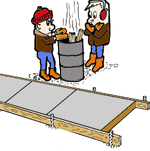|
 |
Cold weather concrete tips
Concrete can successfully placed, finished, and cured in cold weather or during the winter, but it requires an understanding of the impact of cold weather on the process of creating long-lasting concrete.
Fresh and newly-hardened concrete both lose moisture and heat rapidly in cold-weather conditions. You must protect cold weather concrete against early freezing to ensure the development of the proper strength and how that may impact other construction projects that are waiting for the concrete to set and cure.
Cold weather concreting brings special planning. To achieve a long life concrete product during placed during cold weather the production of aggregates, proper design of mixes, proper mixing and transporting, proper placing and finishing practices and special care in protection must be observed.
Following are some tips that should help ensure your cold weather concrete project is completed successfully:
Planning
-
Schedule the proper equipment and manpower to be in place well ahead of time.
-
Plan weather protection to maintain the working environment and the concrete at a temperature sufficient for productive placement and finishing.
-
Consider using low slump concrete for flatwork in cold weather that will cut the setting time and reduce bleed water since cold air retards the evaporation rate and setting time of concrete.
-
Plan to use, or consider using concrete mixes that contain accelerating admixtures or Type III Hi-Early cement that require shorter protection time from freezing.
-
Only consider using concrete mixes that contain fly if your project will be able to be protected from freezing for a longer period of time.
-
Request a heated mix or order 100 lbs of extra cement for each cubic yard of concrete to help develop early strength.

Pre-placement
-
Remove all snow and ice from all concrete forms and the subbase before placing the concrete.
-
Check the temperature of, and heat up if necessary, the subbase and any other surfaces that come in contact with the concrete to ensure they are not below 32° Fahrenheit.

Placement
-
Ensure the minimum concrete temperature, as placed and maintained, exceed 55° Fahrenheit.
-
Make sure the concrete temperature does not rise above 75° Fahrenheit.

Post-placement
-
Do not begin final finishing operations while bleed water is present.
-
Ensure proper finishing with no extra water or excess bleed water worked into the surface or over-finished.
-
Don't over work cooled slabs that exhibit delayed setting characteristics.
-
Ensure that your cold weather concrete has cured and do not allow hardened concrete to dry out.
-
Keep ice from forming - Once ice has formed, hydration stops and strength development is seriously impaired. Fresh concrete frozen during the first 24 hours can lose 50% of its potential 28 day strength!
-
Use insulation blankets or heated enclosures to maintain concrete temperatures above 50° degrees Fahrenheit for three to seven days.
-
Use a good quality curing compound if you are unable to maintain concrete temperatures above 50° degrees Fahrenheit for three to seven days.
-
Maintain the concrete temperature above 40° degrees Fahrenheit for at least four more days after the use of the insulation blankets or heated enclosures.
-
Do not seal freshly placed concrete.
-
Remove the heat protection in a manner that ensures the temperature of the concrete will not drop faster than more than 40° Farenheit in 24 hours.
Concrete can be placed, finished, and cured to its proper strength in cold weather conditions if sufficient planning and care are taken. Call us today at 1-800-245-1333, fill out our contact form, or e-mail us at info@deeconcrete.com to locate a distributor near you that carries dee Concrete Accessories high quality concrete forming products.

|
 |

Related concrete tips and facts:
|

![]()